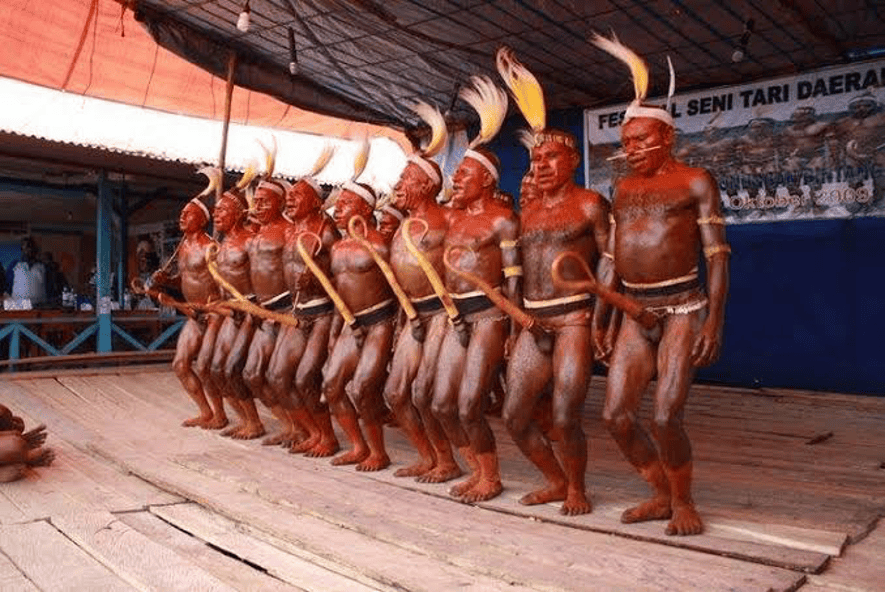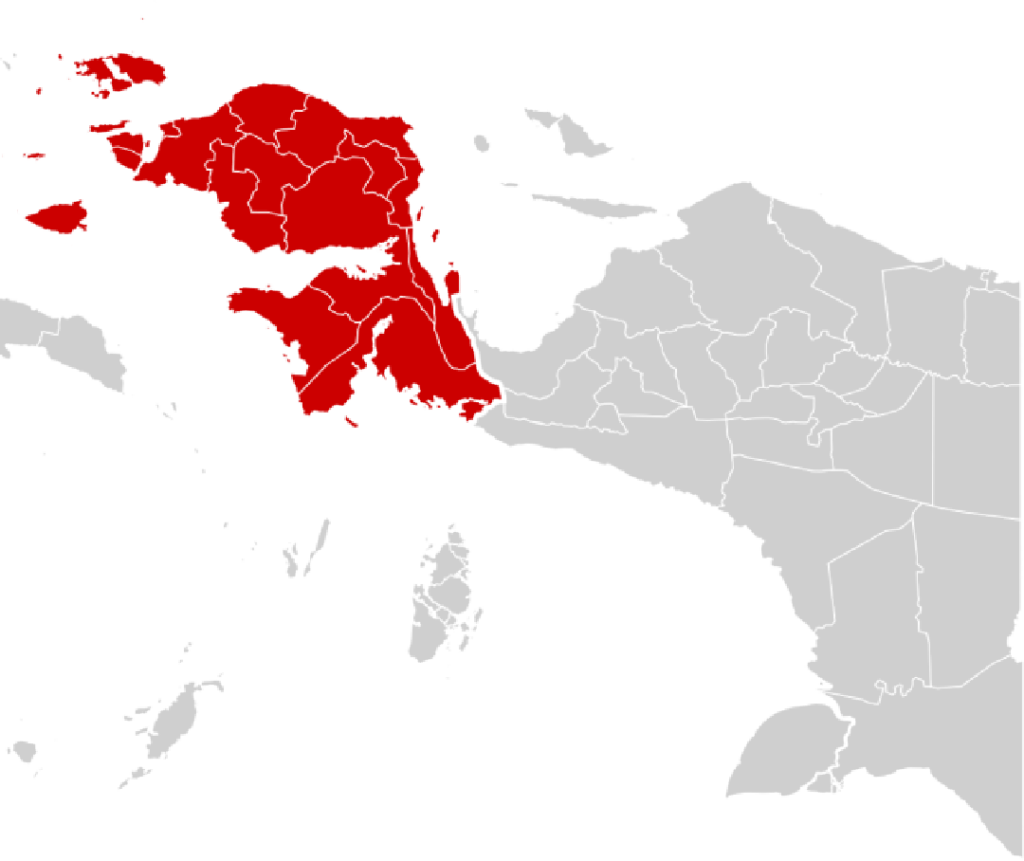PAPUA – Oksang is a traditional dance originating from the Ngalum tribe in the Bintang Mountains, Papua. This dance shows the characteristics of the Ngalum tribe community with the Ok element based on the naming of places in this region, such as:
- Oksibil,
- Okbab,
- Okyop.
And another Ok village name, they are the owners of this dance for new people will be surprised when for him to witness this dance played live, because the dance is only owned by the Ngalum tribe community. This dance is also a dance that is much different from traditional dances from other regions throughout Papua, the way the game is very dynamic and neat.
Administratively, Pegunungan Bintang Regency is an expansion area of Jayawijaya Regency, which at that time had its capital in Wamena. The Bintang Mountains consist of two major tribes, namely:
- Ngalum,
- Ketengban.
Then some other small sub-tribes such as:
- Murob,
- Kambom,
- Batom,
- Kimki,
- Yepta,
- Lepki.
All of these are different cultures and languages. Oksang comes from two syllables, Ok and Sang, Ok meaning water, and Sang meaning god or a creator (Attangki) in the Ngalum language, so Oksang has two meanings:
- Ok or water symbolizes purity, healing, blessing in the house, blessing on cultivated land.
- Sang is the name of God as the creator to be glorified through this dance through song lyrics that have been created by Him.
This dance is a very sacred dance for the Ngalum tribe. Throughout the land of Papua, Oksang dances are rarely performed, when there is an annual cultural festival in Papua, mentioned because the dance is very sacred and prohibited by traditional elders, the place of performance, staged in a house on stilts designed and made in such a way with traditional technology such as:
- Wood,
- Rattan,
- Gaba-gaba.
Each by measuring the level of elasticity so that when the dancers simultaneously move their bodies following the rhythm of the dancers’ footsteps. The dancers harmoniously shake their bodies so that the audience becomes fully attentive to every movement played by the dancers. At the performance venue, a place for the audience is also made which is designed normally so that there is no swaying that can interfere with the concentration of the beauty and excitement of the dancer’s performance.
Since long ago, this dance was usually performed starting with the preparation stage, what distinguishes it is that Oksang dance has a sacred value for the indigenous people of the Bintang Mountains, they call themselves Aplim Apom people, so that non-Aplim Apom are not allowed to watch, given also traditional accessories and clothing since generations, such as:
- Okbul (Koteka),
- Batom Mir (Tanah Merah),
- Nal Kulep (Bulu Cenderawasih),
- Kapnong (Anklet),
- Yapet (Hand bracelet),
- Takol Papi (Stone axe).
As well as other accessories, here for the Ngalum people, especially women and children who have not followed the initiation process, (maturation), are not allowed to know the secret, as well as other tribes outside the Bintang Mountains to know the secret of Oksang, why are women like that? With the intention, that nothing happens that endangers the lives of Ngalum people. In other words, getting a misfortune (curse) from the creator, besides that, accessories that are decorated on the body of a dancer before going down the stage, namely:
- Red soil (batom mir),
- Long Koteka (okbul simit or sangyum),
- Anklets (kapnong),
- Hand bracelet, (yapet) made from bark,
- Rope (nong),
- Stone axe (takol papi) held and leaned on the shoulder,
- Bird of Paradise feather,
- Earring in the ear,
- A piece of Bamboo in hand.
When this dance takes place, it is played and accompanied by a song. The dancers gently move their bodies, as if a dancer is dancing and is in a different world. Each song sung in Oksang dance, tells the story of the journey of Attangki (Allah Aplim Apom) in spreading the universe and its contents as a result of His creation. In addition, the song tells the story of the majesty of Attangki (God) who provides and anoints foodstuffs and the Aplim-Apom people themselves. The songs sung have a relationship between one song and the next according to the direction of travel of the creator spreading and placing tribes and His creations throughout the Negeri Aplim Apom Pegunungan Bintang, because Oksang dances are usually held or performed in the afternoon or evening.
The number of players in Oksang dance ranges from 20-30 dancers, according to the capacity of the stage house. The authenticity of Oksang dance seen from the number of dancers more than 20 people, looks less satisfying and looks not so enthusiastic, so Oksang dance requires more dancers. Because Oksang dances will appear to have artistic value if played by a large number.
Oksang dance in the past, the ancestors of the ancestors of Aplim Apom until today, the Ngalum people are believed that with the Oksang dance performance aims to ask or request for the fertility of agricultural products, livestock, and maintain a healthy body for Ngalum people to the Attangki (God) as the creator and viewed from the point of view of the sacredness of Oksang dance, this dance is required when teenagers or children who are old and have been initiated are required to perform Oksang dance after the initiation process is complete and when the dance takes place, Usually every male after initiation, in the middle of the head of hair, braided from the front of the head to the back under the neck, this indicates that, the spirit of a good man is hidden in the hair braid and repels evil spirits, if seen by women, the boy will get a curse and can die at a relatively easy age or his death time will be very short.
From the time of creation, Oksang dance is still preserved today and this dance is usually played if there is someone who wants to fulfill economic needs, in the tradition of the Ngalum tribe, the person will invite from village A to village B to perform the Oksang dance, in the Ngalum language it is called kurip and the tools or objects brought by village B to give to village A or invited in the form:
- Leaf cigarettes (tobacco),
- Uansun (a type of metal) or as a means of payment,
- Dog’s tooth (anon ningil),
- Stone axe, (takol papi),
- Machete,
- Bag (men/noken),
- Bow.
The Ngalum community held Oksang dances not given an agreement or based on an agreement, because it was inseparable from the sacredness, this dance could be held once a year or even every two years depending on the wishes of the local community when the Oksang dance performance would be held and on the other hand, the Oksang dance was performed after the Ngalum community completed the construction of a traditional house (ap iwol) for men, the process was held with a stone burning ceremony for the blessing of buildings or new traditional houses that had been built. This traditional building or house was built to provide basic education or initiation (Tena Kamil) to men.
With the construction of a traditional house (bokam iwol) and the performance of dances still related to the intention to improve the economic situation, restore health, ask for fertility of plantation products, cattle and land to the creator and besides, with Oksang dance Ngalum community when staged, The audience, especially a woman, has its own allure or attraction to a male dancer to make her future husband, in other words, the Oksang dance performance place is a place to find a mate, especially for women in the Ngalum language called namal unor or chasing from behind to get the man as her husband.


